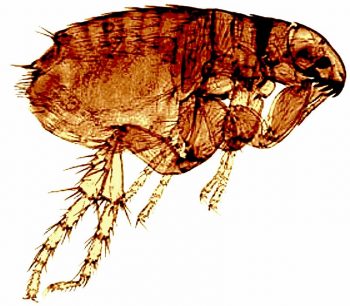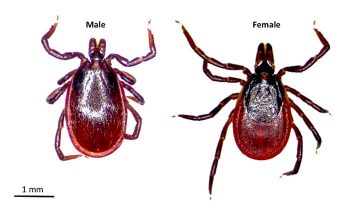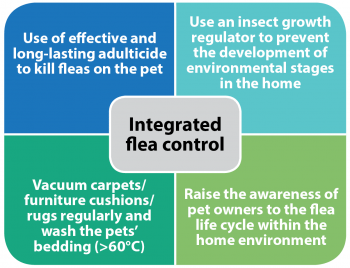9 Oct 2017
Hany Elsheikha discusses the importance of raising the awareness of parasite protection with owners, especially all year-round.

IMAGE: Pixabay/StockSnap.
Flea and tick infestations can cause a wide range of dermatological problems for pets and their owners. Control of these common pests is essential, not only to maintain the health and welfare of the pets, but also to protect people from infestation and the potential transmission of serious zoonotic infections. The fact some pet owners seem unaware of the importance of flea and tick treatment has been a subject of increasing concern in companion animal parasitology practice.
Pet owners are not aware of the negative health effects that repeated flea and tick bites can cause, and they may consider ectoparasitic infestations to be less serious than other health problems. Much has occurred over the past decade on both the professional (increasing awareness campaigns) and industrial (availability of many effective products) levels. However, translating these efforts and concepts into operational-level awareness and the implementation of robust parasite management still requires more attention. Proactive counselling, novel strategies targeting pet owner compliance and individualised preventive interventions are all needed, and potentially crucial, to achieving effective control of fleas and ticks.
This article provides a brief description of the impact of flea and tick infestation on pets and their owners, and interrogates reasons underpinning the lack of awareness of some pet owners about the need for year-round protection, as well as proposing solutions to tackle this challenge.
Raising awareness of the need for flea and tick prevention in dogs and cats is more important than ever. Companion animals have always suffered from ectoparasite infestations, particularly fleas and ticks. Infested animals often experience severe irritation and allergic reactions.
Fleas and ticks can also transmit many infections to animals and humans. Unfortunately, the high risk to pets and their owners of flea and tick infestation is not paralleled by a necessary level of awareness and compliance by pet owners.
A cross-sectional survey of dog owner opinions and actions in the US showed their flea and tick treatment adherence fell short of vets’ recommendations (Lavan et al, 2017). This is not the responsibility of pet owners alone; it also lies on the shoulders of other stakeholders, such as veterinary professionals and ectoparasiticide drug companies.
In the following sections, the clinical impact caused by fleas and ticks are discussed, along with approaches to treatment and prevention.
Fleas are the most prevalent ectoparasites infecting dogs and cats, with around 1 in 10 dogs and 1 in 5 cats having fleas at any given time. Considerable media campaigns have raised awareness of the risk of flea infestation. According to the UK PDSA Animal Wellbeing (PAW) Report of 2017, 82% of dogs, 82% of cats and 13% of rabbits were treated for fleas.

Some owners, however, remain unaware of the potential for unprotected pets to pick up fleas from the garden and park – or wherever wild animals, stray cats and untreated animals may have been. Even indoor pets can be affected by fleas carried into the home on clothing or other materials, or wandering stray cats. Pets can be infested with various flea species, for instance the “cat flea” (Ctenocephalides felis, Figure 1) can infest cats and many other animals, such as dogs, rabbits and hedgehogs. The “dog flea” (Ctenocephalides canis) is found on dogs, but rarely on cats, especially in more temperate climates. The human flea (Pulex irritans) also can infest both humans and pets.
Owners should also realise their pets can easily pick up ticks (Figure 2) by walking in long grass and vegetation where ticks wait to latch on to the next host. Ticks are often found in woods, or areas of low shrubs or tall grass. They climb 1ft to 2ft from the ground into the shrubs or grass and wait until an animal brushes by to crawl on to. It is not just pets that can get ticks; humans can get them, too. Tick bites spread Lyme disease and other infections to pets and people, so employing effective preventive treatments are important.
Owners need to understand the importance of keeping their pets protected. A greater understanding of the veterinary medical and public health impacts of flea infestation will help the majority of pet owners realise this.
Flea infestations can result in intense itching, pruritus and scratching – leading to inflammation, fur loss and secondary bacterial infections. Animals with flea allergy dermatitis (Elsheikha, 2012), due to an allergic reaction to antigens in flea saliva and/or dirt, can develop severe irritation and inflammation from a single bite, while heavy infestations in puppies and kittens can lead to life-threatening anaemia due to feeding on the pet’s blood. Fleas carry the risk of tapeworm infestation because tapeworms spend part of their life cycle inside fleas.
Fleas are the intermediate host for the dog and cat tapeworm Dipylidium caninum. Controlling fleas will also prevent tapeworm infections that can also affect humans, particularly children. Fleas may also carry blood-borne infections, such as Bartonella henselae, which can cause flu-like symptoms in people. Other blood-borne pathogens that have been isolated from fleas include Rickettsia felis and Haemoplasma species (causing anaemia in cats) and Yersinia pestis (causing plague, a life-threatening infection if not treated promptly).
Ticks also can compromise the health of the affected animal through multiple mechanisms. Blood-feeding and engorgement of multiple adult female ticks can lead to severe anaemia and immunosuppression. Secondary bacterial infection of bite sites can lead to dermal pathologies or pyogenic lesions. Toxins secreted in the saliva of certain ticks can cause tick paralysis. Due to their haematophagous (that is, they feed on blood from the vertebrate animals) and vectorial capabilities, ticks can transmit many disease-causing pathogens that are even more serious than the damage caused by ticks themselves (Elsheikha, 2016a). Two examples, canine ehrlichiosis due to Ehrlichia canis and canine babesiosis due to Babesia gibsoni and Babesia canis, can cause significant ill health in dogs. Infections may progress to become chronic disease, resulting in immunosuppression and pancytopenia (in case of ehrlichiosis), or haemolysis and shock due to multi-organ ischaemia (in the case of babesiosis).
Fortunately, babesiosis is rare in British dogs, with most cases being acquired abroad. However, the detection of a cluster of dogs with babesiosis in Harlow in 2016 – some of which had not travelled abroad – raised concerns the disease may become endemic in the UK. Ticks are also responsible for the spread of zoonotic diseases to humans; for example, Lyme disease, human babesiosis, human granulocytic ehrlichiosis, tularaemia and rickettsial diseases.
It is essential all veterinary practice staff understand the indications and side effects of each available product to make consistent recommendations regarding the suitability of products for each pet. This also requires all staff to have a basic understanding of flea life cycles so they can advise owners on correct treatment of environmental flea and larvae contamination.
Anti-flea products are divided into adulticides (kill adult fleas) and insect growth regulators (IGRs), which prevent the development of the eggs and larvae. The main groups of insecticides against fleas have been described in another article by the author (Elsheikha, 2017). The need to use host-targeted and environmental insecticides for eliminating flea stages in a pet’s environment has led to the development of products combining an adulticide with an IGR (such as methoprene or pyriproxyfen) or insect development inhibitors (such as lufenuron). These, along with environmental measures, can achieve an integrated flea control programme (Figure 3).
IGRs mimic an insect growth hormone, preventing immature stages from developing. Lufenuron prevents the egg tooth from hardening so larvae cannot hatch from the egg. IGRs may be used directly in the environment in the form of spray and foggers, which are used for existing infestations. IGRs can also be used in combination with an adulticide on the animal, to prevent infestation from occurring by disrupting the flea’s reproductive cycle. Although most adulticides will kill fleas within one day prior to egg laying, owner compliance is generally poor and some fleas may survive for long enough to lay eggs at the end of the treatment interval. Therefore, the use of an IGR at that stage will render eggs already laid unable to cause infestation.
The best treatments against ticks kill them before they bite, stopping the spread of disease. A number of anti-tick products can be used to reduce the risk of exposure of pets to ticks. Choice of product must be based on lifestyle factors, geographical location, previous tick exposure, travel to an endemic region/country, owner affordability and preference (tablet, collar or spot-on), and other drug requirements for the pet. Some products contain pyrethroids, which have a tick-repellent (prevent tick from taking a blood meal), as well as having insecticide and acaricide effects (Elsheikha, 2017). Tick treatment of pets entering the UK, although not obligatory, is still needed to protect travelling and resident pets. A Lyme disease vaccine is available and should be discussed with pet owners based on the individual risk to the animal.
It is important to note cats can develop toxicity if a canine permethrin product is applied inappropriately, or via secondary contact with a dog treated with a spot-on product containing permethrin. It is advisable to avoid the use of permethrin-containing products on a dog that shares a home with a cat.

Some collars, such as Seresto, which contains 10% imidacloprid and 4.5% flumethrin, have been developed for use on dogs and cats. This product contains both repellent and insecticidal properties and has been shown to reduce tick counts by at least 90% and flea counts by at least 95% for a period of at least seven to eight months in cats and dogs under field conditions (Stanneck et al, 2012a; 2012b).
All licensed macrocyclic lactone preparations are safe; even for MDR1 (avermectin-sensitive) dogs, which are often collie-type breeds. However, these breeds of dogs are more sensitive to overdoses and it is important to avoid giving more than one of these avermectin-containing products. These substances bind with p-glycoprotein transporters, hence their use with other drugs using the same targets (such as digoxin and doxorubicin) can enhance toxicity.
The persistence of fleas in the environment and on pets following treatment has raised concern of insecticide resistance. However, even though resistance genes have been found in laboratory strains of flea, some flea products (such as fipronil, selamectin and spinosad) have been shown to remain efficacious (Bass et al, 2004; Dryden et al, 2013). The perceived failure of flea treatment can be due to a number of factors.
These include:
Additionally, more intensive monitoring and treatment may be necessary in animals with flea bite hypersensitivity to achieve a successful outcome.
Protective measures should be adopted to control ticks, such as the avoidance of tick habitat (including heavily wooded and grassy areas) and using repellents and frequent “tick checks” (at least one check per day) to pick up and remove ticks with a tick removal device or fine-pointed tweezers, before they can transmit disease. Even though the average transmission time for Borrelia (the agent of Lyme disease) and Babesia is one to two days, transmission can occur within 16 hours and the minimum attachment time for transmission of infection remains unclear. It is possible Rickettsia and Ehrlichia can be transmitted quickly (within three to four hours).
In general, transmission is correlated to the duration of tick attachment; therefore, it is advisable to use products that kill or repel ticks as quickly as possible to reduce the risk of disease transmission.
Parasite preventive medicines are only effective in protecting the treated animal when they are used according to appropriately prescribed recommendations. Therefore, regardless of veterinary advice, failure of owner compliance will reduce the success of any ectoparasite treatment recommendations provided to the client. This might also lead to a lack of pet owner confidence in the recommendations, a reduction in retail spending and, potentially, adverse consequences to animal health. Therefore, improving compliance is crucial.
It is important for practice staff to be able to identify causes of treatment failure (due to lack of compliance or other reasons), and address and correct this with pet owners. Recommendations for maximising pet owner compliance to flea and tick control have been provided (Biggle, 2016; Elsheikha, 2016b).

Fleas and ticks are common pests of dogs and cats. Significant progress has been made in the development of ectoparasiticides over the past few decades. The market is flooded with products regularly, giving owners and practices high flexibility in choosing the most effective option to suit their needs.
Most flea and tick products contain one or more ingredients that have insecticide and/or acaricide effects and several combination products cover fleas and roundworms. Ectoparasiticides can be used to kill parasites already on the animal’s body, and can kill newly acquired parasites to prevent reinfestation. It is important dog flea treatments are not used on cats because this can be fatal.
The rapid transmission times of rickettsial diseases, and the presence of the protozoan Leishmania infantum in southern Europe, makes it necessary to use tick and sandfly repellents when travelling to countries where these pathogens are common. The author envisages future ectoparasite control as one that continues to rely on ectoparasiticides, providing clinicians with more, and effective, tools to tackle the challenge of flea and tick infestations.
Finally, when it comes to flea and tick control, clinicians must make professional and business judgements to ensure the requirement for meeting client expectations, improving pet health and maximising the practice revenues, without skewing practice policy and imposing a disproportionate burden on their clients.
The author declares this article was written in the absence of any commercial or financial relationships that could be construed as a potential conflict of interest.